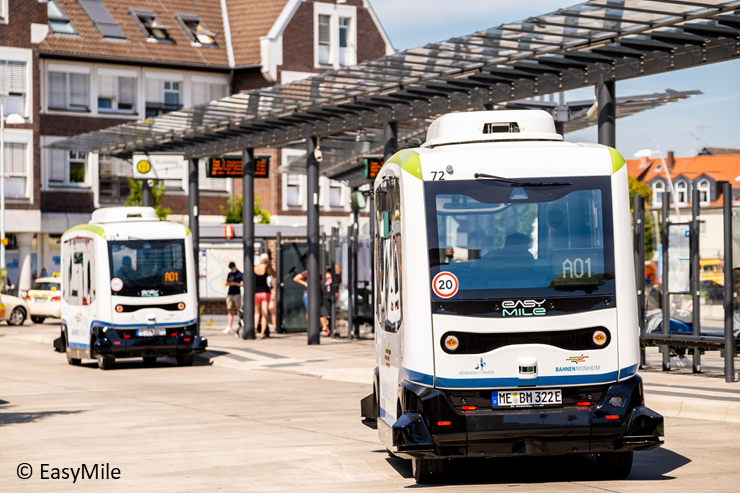Accompanying Research of automated minibuses in Monheim
- contact:
- funding:
Stadt Monheim
- start:
2021
- end:
2023
Accompanying Research of automated minibuses in Monheim
Problem Statement
Since February 2020, automated minibuses from the EasyMile company have been in operation in the city of Monheim every 15 minutes from 7 am to 11 pm. With a driving speed of about 10 km/h and space for up to 11 passengers, the minibuses connect a total of eight stops in the historic old town of Monheim in regular service, where conventional bus operation is not possible due to narrow alleys. The routing involves complex traffic situations with interactions with other road users of all transportation modes. Such a deployment of automated buses in a regular service and their integration into the daily traffic flow is unique in the world. It is therefore unclear how the novel offer will be accepted by the citizens of Monheim and non-residents, what effects the use of minibuses in public road space will have on other road users and thus influence the mobility behavior in Monheim.
Objective
As part of the accompanying research for the autonomous buses in Monheim, the acceptance of the new service is to be determined and the effects on the mobility behavior of the citizens of Monheim are to be examined. To this end, both users and non-users of the service will be included. In addition, behavioral changes such as learning and habituation effects will be recorded during the two-year project period, and the influence of changes in the service on usage will be investigated. Based on this, recommendations are to be derived for adapting the service of the automated buses and the potential of the service is to be determined.
Methods
In order to gain a better understanding of the operational situation of the automated minibuses and their influence on the traffic situation in public transport, operational data such as position, movement, status and environment data as well as data from the operations control system will be analyzed in a first step. The acceptance of the new service will be investigated using two different survey concepts. By means of a targeted passenger survey, insights can be gained, among other things, into usage motives, satisfaction with the service and the connection between the use of the minibuses and the everyday mobility behavior of the users. Passenger surveys will be conducted several times during the project in order to determine changes in the perception and use of the automated minibuses. In addition, passengers will be observed during their trips in order to analyze their reactions to certain traffic situations and draw conclusions about their perception of safety. A supplementary household survey will be conducted using a combined revealed- and stated-preference survey concept to investigate the effects of the automated minibuses on the general mobility behavior, in particular the mode choice behavior, of the entire population of Monheim. Conducting a household survey allows reaching non-users of the service, which also allows evaluating reasons for non-use of the minibuses. The results of both surveys can be used to derive possible adjustments to the offer in order to increase the acceptance of the automated minibuses in the future. The empirical database also enables the determination of quantitative models of travel behavior, which allows conclusions to be drawn about the potential demand for automated minibuses among the population.

